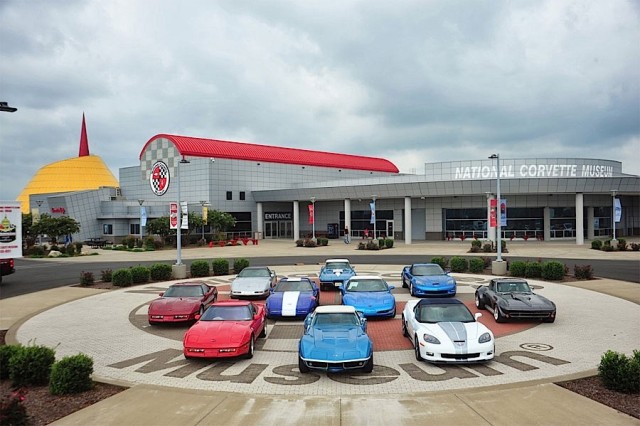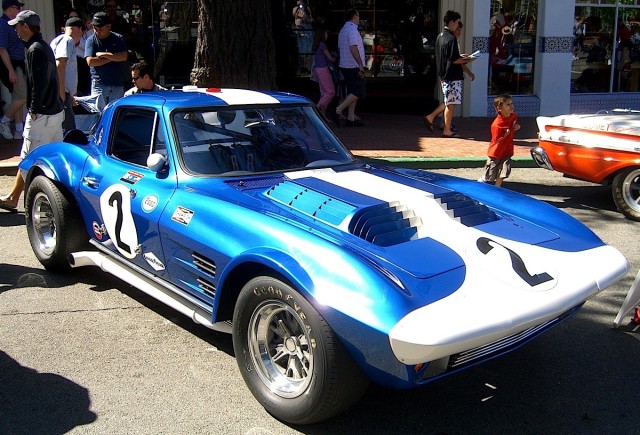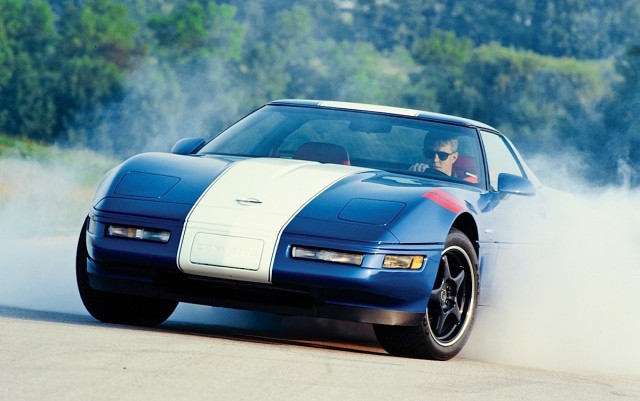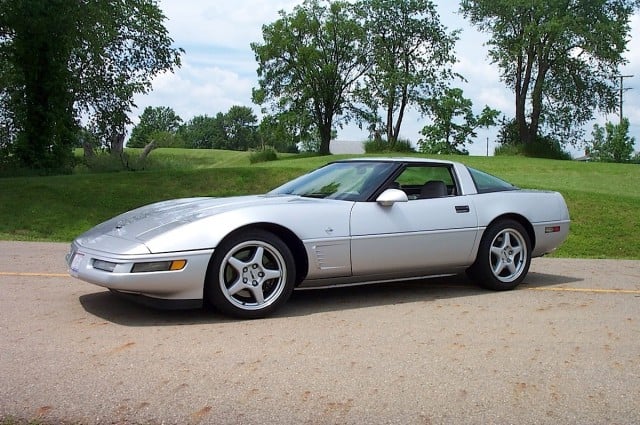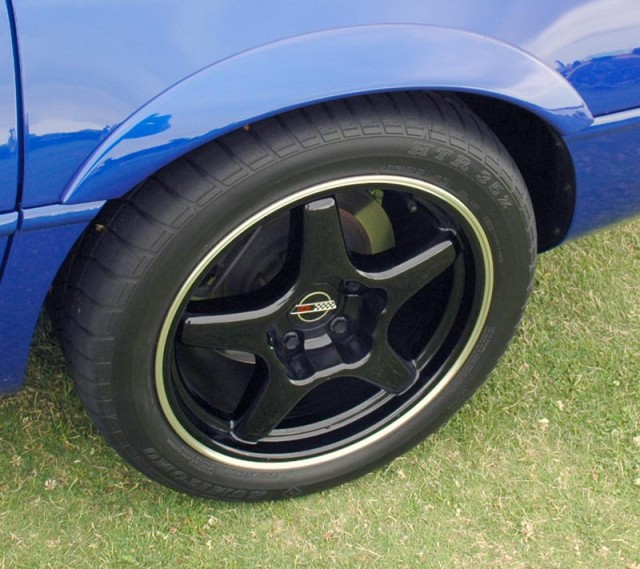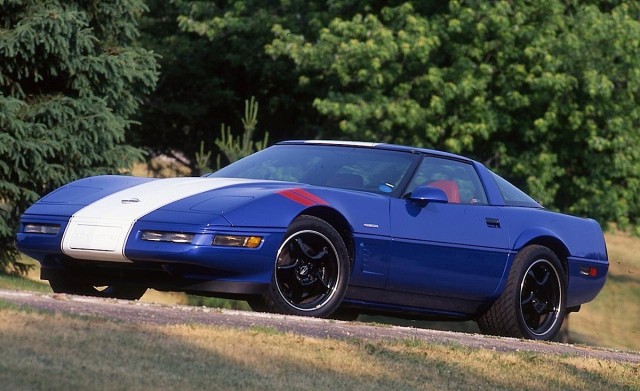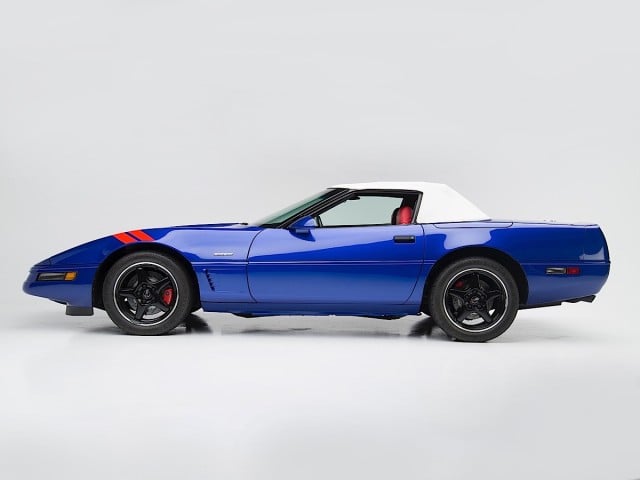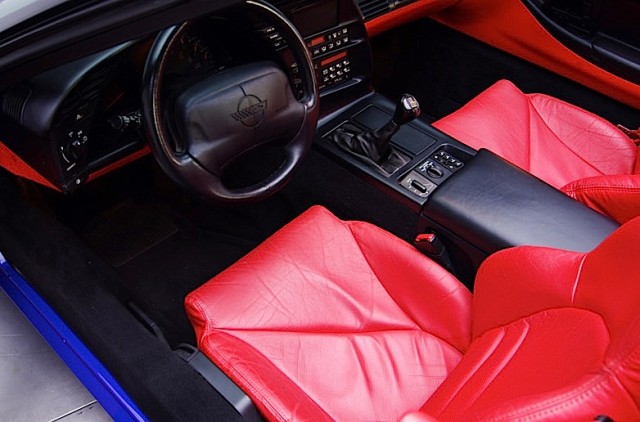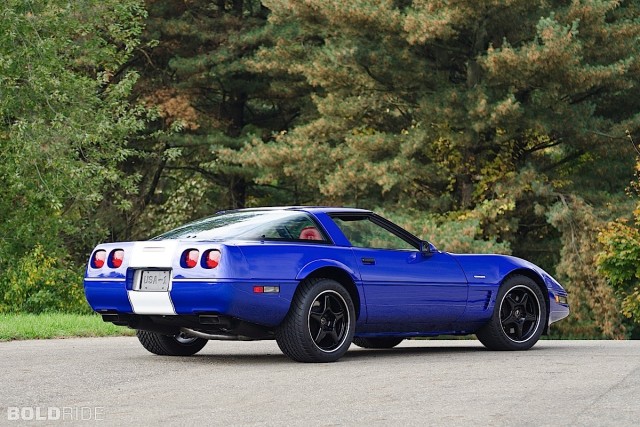 [1]We recently attended the C4 Gathering at the National Corvette Museum in Bowling Green, Kentucky. Aside from the opportunity to check out the Skydome progress and see the great new displays, we had the opportunity to sit in on a few presentations.
[1]We recently attended the C4 Gathering at the National Corvette Museum in Bowling Green, Kentucky. Aside from the opportunity to check out the Skydome progress and see the great new displays, we had the opportunity to sit in on a few presentations.
One such session was conducted by John Heinricy and Jim Minneker. He also happens to own C4 Grand Sport serial No. 1, but we will touch on that a bit later. Heinricy had some awesome first-hand information, and even told a few stories that few people have ever heard about his experiences working for GM.
Heinricy began, “The whole Grand Sport idea started back in 1993. The car was basically in production early in 1995, resulting in a two-year cycle from mere discussion to completion. From an engineering standpoint that is a pretty quick program for General Motors.”
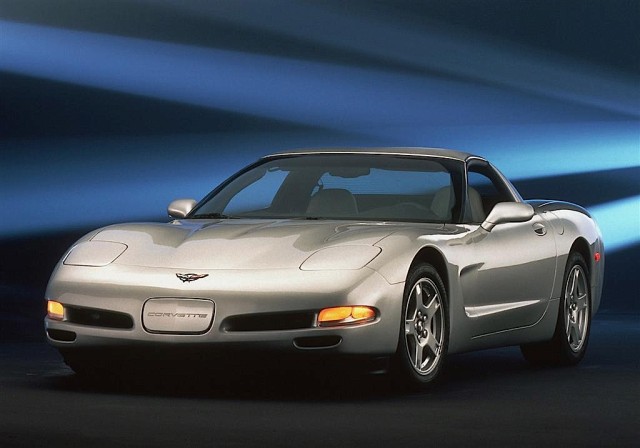 [3]“The Corvette team was discussing exactly what cars would be available for the last year of the C4’s production in 1996,” he continued. “When you are nearing the end of production for a particular generation, the public is waiting to buy the new car, and in this case it was the C5. So, in our case, the buyer needed some extra reasons to buy a C4 in the last year. Typically there are collector editions and so forth.”
[3]“The Corvette team was discussing exactly what cars would be available for the last year of the C4’s production in 1996,” he continued. “When you are nearing the end of production for a particular generation, the public is waiting to buy the new car, and in this case it was the C5. So, in our case, the buyer needed some extra reasons to buy a C4 in the last year. Typically there are collector editions and so forth.”
“When it comes to special editions, marketing typically wants some changes that will drive high-volume sales for the remaining year. A specialized car that only sells a few hundred units is not preferred as it spurs interest, but not sales,” Heinricy said. “Marketing wants some appearance changes, and almost always wants functional changes; the types of things that appeal to a lot of buyers. Unfortunately, engineering is usually reluctant to similar changes due to budgets, time, and design constraints.”
Whereas, much on the contrary, “Engineering typically prefers to make little or no changes, minimize engineering, conserving their budget, and redesign work. Off-the-shelf components are preferred, as they are already built and have been validated,” he said.
The Grand Sport Takes Flight
Heinricy continued, “From the very beginning, the styling department was really pushing the design package. John Guferro was producing sketches of the Penske cars and AJ Foyt’s car, which sported the two marks on the front fender. Styling wanted a blue car with a white stripe, red hash marks, a white mustache on the front grille, blue convertible tops, blue door handles, black wheels, and black brake calipers.” A tall order perhaps, but not unreasonable you might think.
“The plan for functional changes to the car were to improve both handling and performance. Performance would typically include power increases, gearing changes, and whatever else we already had readily available to put into the car. Suspension tuning is always a possibility, but it would have to be from existing parts off the shelf,” Heinricy explained further. “If you look at the handling standpoint of the C4 prior to 1996, we had been though all the options available; we had done suspension tuning like crazy, and changed the tires two or three times in the life of the car. From an option standpoint improving the tire is one of the biggest changes you can make. That being said, for a one-year program, that just wouldn’t work.”
Jim On The Powertrain
“During this time, the Corvette platform was immense. There was the LT5 engine’s coming and going, and the C5 plan had stopped and started several times. Originally Heinricy’s charge in all of this was to maintain the quality, if not raise the quality of the C4 as it went to sunset. He got the assignment to cover this delicate process and he met with the suppliers to do so,” Minneker said.
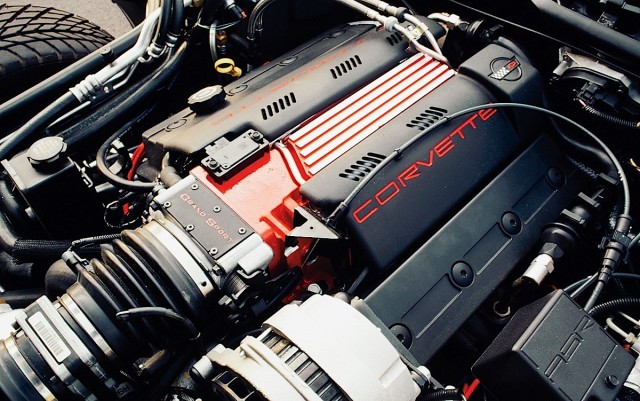 [5]“We knew we needed increased power, and designing a new motor for one year was out of the question. Ultimately we decided we would go back to the ‘old racer tricks’ by getting a little more air in it, getting a little more fuel in it…and revving it! And as most of you know, you have to give up a little something to get those gains, and it’s usually something like idle quality,” Minneker continued. “People who understand the tradeoffs are really happy with that tradeoff, the corporate-end typically does not understand it. Heinricy did of course, so we had a little soft spot in this project. This allowed us to trade off some idle stability for more performance, and thats essentially what we did for the LT4.”
[5]“We knew we needed increased power, and designing a new motor for one year was out of the question. Ultimately we decided we would go back to the ‘old racer tricks’ by getting a little more air in it, getting a little more fuel in it…and revving it! And as most of you know, you have to give up a little something to get those gains, and it’s usually something like idle quality,” Minneker continued. “People who understand the tradeoffs are really happy with that tradeoff, the corporate-end typically does not understand it. Heinricy did of course, so we had a little soft spot in this project. This allowed us to trade off some idle stability for more performance, and thats essentially what we did for the LT4.”
“To gain the desired power, and build engine components that could sustain it, we gave the powertrain department $300, we thought the LT4 would need an all new valvetrain and a steel crank. The team was able to ‘roll some edges’ to reduce stress in the crank, and we ended up not needing the steel crank after all. Powertrain ultimately just had to source new roller rockers with a different ratio for additional valve lift to provide the revving capability and horsepower we wanted.”
Heinricy stepped back in saying, “First off, we talked about the need for better handling, and all we had at that point were the ZR1 tires as an improvement. I also had an initiative to look at new shock absorbers on my desk. So while it wouldn’t normally fly for one year, there was an opportunity to go with a new supplier, Delphi.”
The Grand Sport Issues
“When we put together this package and presented the Grand Sport to marketing, we said “Here is our engine package, we don’t know what it’ll make but it should get about a 10-percent increase, we want to use these tires and wheels, and this paint, and so forth,” said Heinricy. “Well marketing just replied that it was too expensive for high-volume production, and they weren’t willing to sign up for 1,000 units, as sales thought the appearance was too polarizing, and not enough people would want to buy a car that looked that way.”
“I came up with the idea to make a second model, a ‘Collector Edition’ to increase sales, allowing us to still build the Grand Sport. A new silver color was already for production for 1995, so Guferro made sketches with the new color and I had to talk marketing into not using the new color for the C5,” said Heinricy”. They bought into it, and that’s how we ended up with the Collector Edition Corvette which sold quite well. Ultimately, the Special Edition design allowed us to get the Grand Sport into production.
“The next issue presented itself within the powertrain department, as they simply couldn’t do a third engine. There was a new OBDII certification for 1995, which proved to be too costly for the LT5. Since we would have had to rectify all the motors anyways for the OBDII for the 1996 models, we were able to push the LT4 through without any additional costs to the department,” explained Heinricy.
He continued, “There were a lot of issues on the styling side with the white stripe, as far as problems at the plant were concerned. The paint team really tried to make them work, but it just wasn’t possible in the production cycle. The type of time and labor it would take to make the paint edges flush was suited for a paint shop, not production.”
“Also, since the bumpers were painted off the car, getting the stripes to align was just not possible,” Heinricy explained. “Due to these hurdles, the stripes were changed from paint to decals, and the mustache paint scheme was canceled. Additionally, the blue top idea also had to be scrapped, as they were unable to get a fabric to match the Admiral Blue paint color. There was just no dye available that could produce the same hue on fabric.”
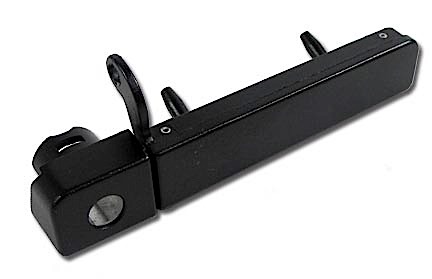 [9]“The door handles are built with a very inexpensive metal, that get coated with a crinkle coat black finish to hide any imperfections. The metal is porous and not smooth enough to paint the body color,” Heinricy said. “There were a few sets of handles completed successfully using body-filler to smooth the surfaces, but it took too long to complete, and that concept was scratched. One car did leave the plant with the blue door handles, which was a convertible; it was Tom Daleworth’s car.”
[9]“The door handles are built with a very inexpensive metal, that get coated with a crinkle coat black finish to hide any imperfections. The metal is porous and not smooth enough to paint the body color,” Heinricy said. “There were a few sets of handles completed successfully using body-filler to smooth the surfaces, but it took too long to complete, and that concept was scratched. One car did leave the plant with the blue door handles, which was a convertible; it was Tom Daleworth’s car.”
“Another issue was that the ZR1 wheels made the tires stick out of the wheelwells too far. Scott Reyon down at the desert proving grounds discovered a way to modify the knuckle and spacer, but it proved to be too much work to utilize these wheels,” said Heinricy. We ended up contacting the wheel manufacturer, and they agreed to make a change to the their tooling. This was actually very inexpensive and allowed us to modify the wheel design, utilizing the wider tires on the coupes. The convertibles did not receive the tires and wheels because the larger set would not fit in the trunk of the convertible should you have to change a flat.”
“The next issue came from the quality department, who decided they couldn’t allow the new rear tires to stick out, however slight. The choice to use the export flare was the only available option considering the late stages of production that we were in. While not everyone loved the idea, we decided it was better than reducing the tire size, explained Heinricy.
 [11]He continued, “The black brake calipers presented some challenges as well. The stock calipers were a real eyesore with the black wheels, and we couldn’t just leave them. Again, the casting was inexpensive which created a lot of issues when it came to painting. The provider agreed to used a different metal which ultimately resulted in a caliper that was much stronger and heat resistant. These calipers were also used on the Camaro and Firebird in 1997.”
[11]He continued, “The black brake calipers presented some challenges as well. The stock calipers were a real eyesore with the black wheels, and we couldn’t just leave them. Again, the casting was inexpensive which created a lot of issues when it came to painting. The provider agreed to used a different metal which ultimately resulted in a caliper that was much stronger and heat resistant. These calipers were also used on the Camaro and Firebird in 1997.”
Heinricy said, “As we were getting closer to completion, we had a holiday shutdown in July and left for a week or two. We left the cars sitting on the lifts during this time. When we returned, we set the cars down and parked them. We later noticed that each car had four small puddles of oil at each corner. We discovered that when the shocks were left at full rebound, the seals unseated. When we set the cars back down, the seals would not seat correctly, and because they were pressurized, oil began to seep from each shock. We tried to resolve it, but we could not come up with a fix in the time we had remaining.”
He continued,”I went on my knees to Bilstein and said, ‘We need help, we need your shocks back in the plant, and by the way we need to fully re-valve them.’ Basically in a days time, Mike Neil figured out a new valving setup for the Grand Sport, and Bilstein said that as long as we came up with a combination of parts that were already on the shelf, then they could make it work. We were slightly delayed because of it, but we made up for the lost time and ultiatmely didn’t lose any production.”
Seriel #1
Back on September 16, 1994 Heinricy wrote a letter to Harry Turner. Basically Heinricy had the idea he wanted to buy one of the Grand Sports, in particular he wanted to buy car No. 1. Turner was the project manager in marketing for the Corvette, for both C4 and C5. Turner acknowledged that he had received the letter, but nothing happened for quite sometime. Heinricy explained, “Now as it turned out, the way GM was setup to build cars at the time, was to build several pilot cars which didn’t have fully certified parts in them. We usually ended up scrapping them or they would be turned into a test car for a future program.”
He continued, “Since the C5 was coming, we didn’t have a use for the pilot cars. We probably had to build 30 or 40 cars between the Grand Sport and Collector Edition, so Turner told me I had to figure out how to turn these cars into sellable2 cars. I really wanted that No. 1 so that probably had something to do with me figuring out a solution. It’s amazing how people tend to get a job done when they’re incentivized.”
Heinricy added, “Anyways, in Spring of 1995 I hadn’t heard anything, and I saw Jim Herkins at an event. I asked if he had heard about my interest, and Herkins expressed that he’d look into it, but warned me that they typically auction the No. 1 car off for charities and that sort of thing.”
Heinricy finally heard back. He explained, “I was told which dealer it was going to, and that I’d have to make a deal with them. The car went to Colley dealership in the Detroit area. When I went to pick it up, I said that I needed the title as it actually said ‘Pilot Corvette’ on it. A new original would be sent to me, but I wanted that title. The salesman wouldn’t dare leave it with me, to the point he took it with him every time he left me at his desk. He did, however, make me a copy, and I obviously ended up buying the car. It currently has around 15,500 miles on the odometer.”
“I don’t tell many people this story, but a couple days before Grand Sport No. 1 would leave the plant, I saw that it had an odometer reading of 7,000 miles on the paperwork. Now, the more milage a car had on it, the bigger the discount was to the dealer. In this case that meant more savings to me. The next discount level was at 7,500 miles, and I found myself wondering how in the hell I was going to get 500 more miles on the car in one night,” Heinricy explained.
“So that night I came back to the proving grounds at about 10:00 p.m. and took the car out to the circle track. I ran the car at about 150 to 160 mph for 500 miles,” Heinricy said. “I’d stop to fill it with gas, and go back out. When you think about it, it doesn’t take long to get 500 miles on a car when you’re doing 150 mph. It’s a good thing my pension doesn’t come from GM!”
